maintenance NISSAN NV PASSENGER VAN 2018 Owners Manual
[x] Cancel search | Manufacturer: NISSAN, Model Year: 2018, Model line: NV PASSENGER VAN, Model: NISSAN NV PASSENGER VAN 2018Pages: 426, PDF Size: 4.52 MB
Page 1 of 426
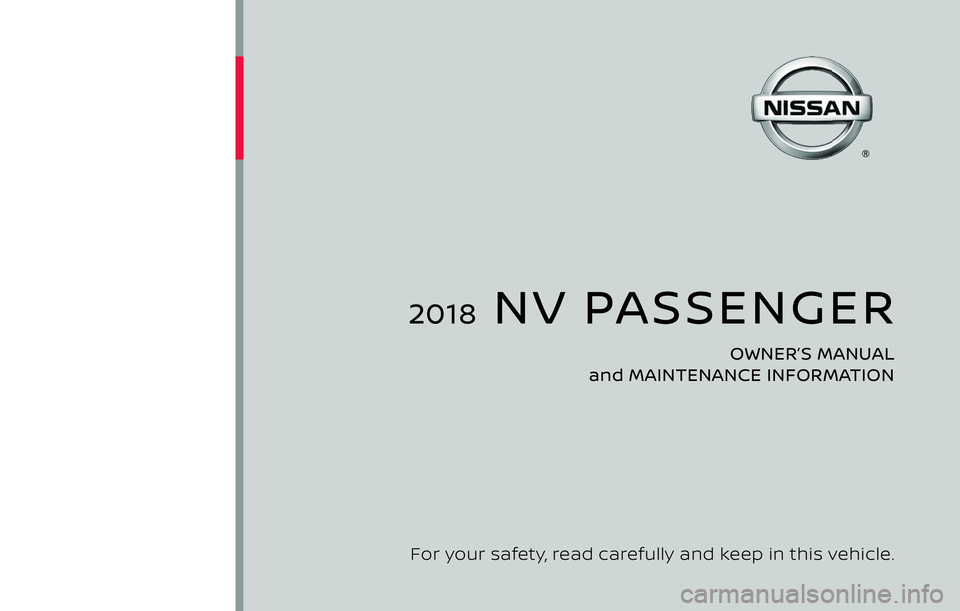
2018 NV PASSENGER
OWNER’S MANUAL
and MAINTENANCE INFORMATION
For your safety, read carefully and keep in this vehicle.
Page 2 of 426
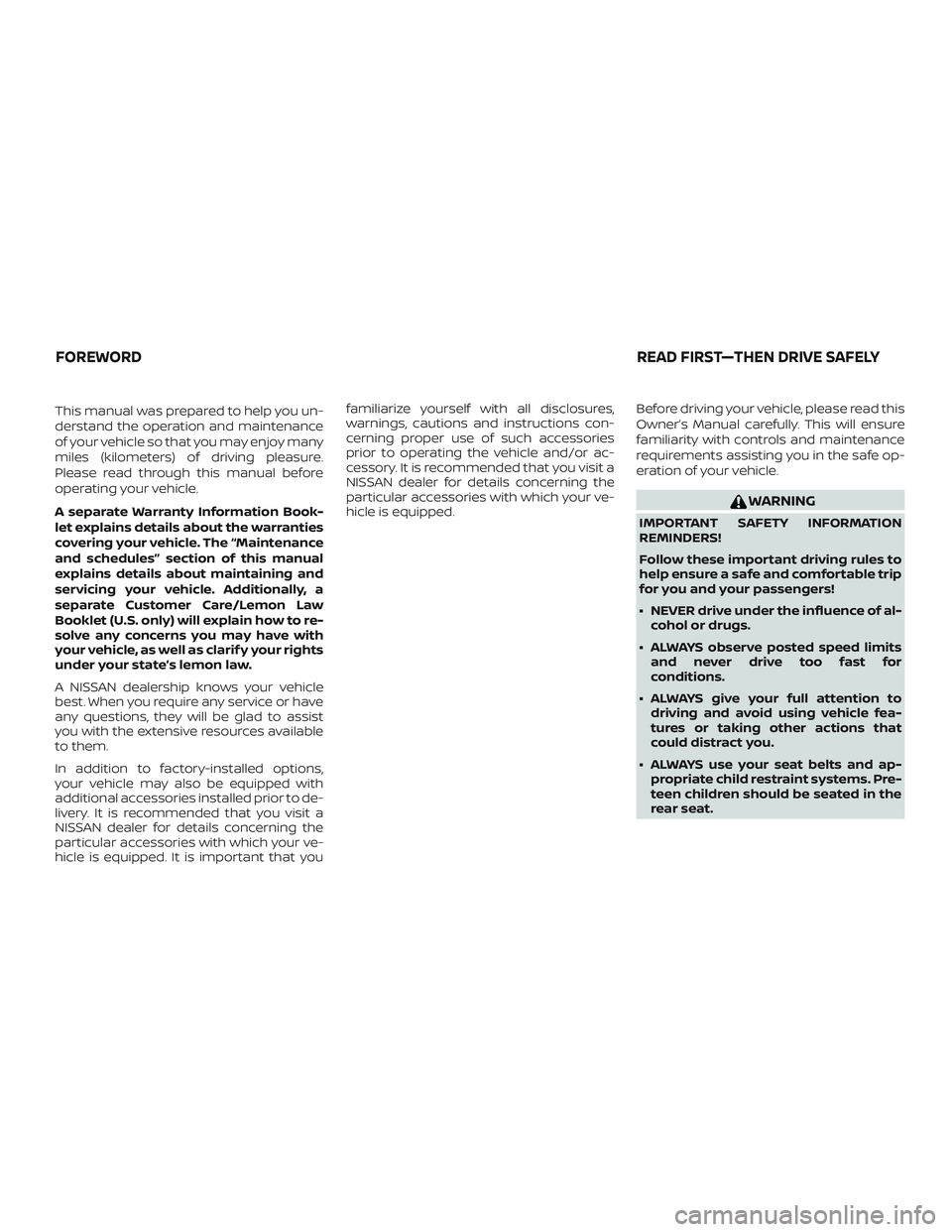
This manual was prepared to help you un-
derstand the operation and maintenance
of your vehicle so that you may enjoy many
miles (kilometers) of driving pleasure.
Please read through this manual before
operating your vehicle.
A separate Warranty Information Book-
let explains details about the warranties
covering your vehicle. The “Maintenance
and schedules” section of this manual
explains details about maintaining and
servicing your vehicle. Additionally, a
separate Customer Care/Lemon Law
Booklet (U.S. only) will explain how to re-
solve any concerns you may have with
your vehicle, as well as clarif y your rights
under your state’s lemon law.
A NISSAN dealership knows your vehicle
best. When you require any service or have
any questions, they will be glad to assist
you with the extensive resources available
to them.
In addition to factory-installed options,
your vehicle may also be equipped with
additional accessories installed prior to de-
livery. It is recommended that you visit a
NISSAN dealer for details concerning the
particular accessories with which your ve-
hicle is equipped. It is important that youfamiliarize yourself with all disclosures,
warnings, cautions and instructions con-
cerning proper use of such accessories
prior to operating the vehicle and/or ac-
cessory. It is recommended that you visit a
NISSAN dealer for details concerning the
particular accessories with which your ve-
hicle is equipped.
Before driving your vehicle, please read this
Owner’s Manual carefully. This will ensure
familiarity with controls and maintenance
requirements assisting you in the safe op-
eration of your vehicle.
WARNING
IMPORTANT SAFETY INFORMATION
REMINDERS!
Follow these important driving rules to
help ensure a safe and comfortable trip
for you and your passengers!
∙ NEVER drive under the influence of al-
cohol or drugs.
∙ ALWAYS observe posted speed limits and never drive too fast for
conditions.
∙ ALWAYS give your full attention to driving and avoid using vehicle fea-
tures or taking other actions that
could distract you.
∙ ALWAYS use your seat belts and ap- propriate child restraint systems. Pre-
teen children should be seated in the
rear seat.
FOREWORD READ FIRST—THEN DRIVE SAFELY
Page 8 of 426
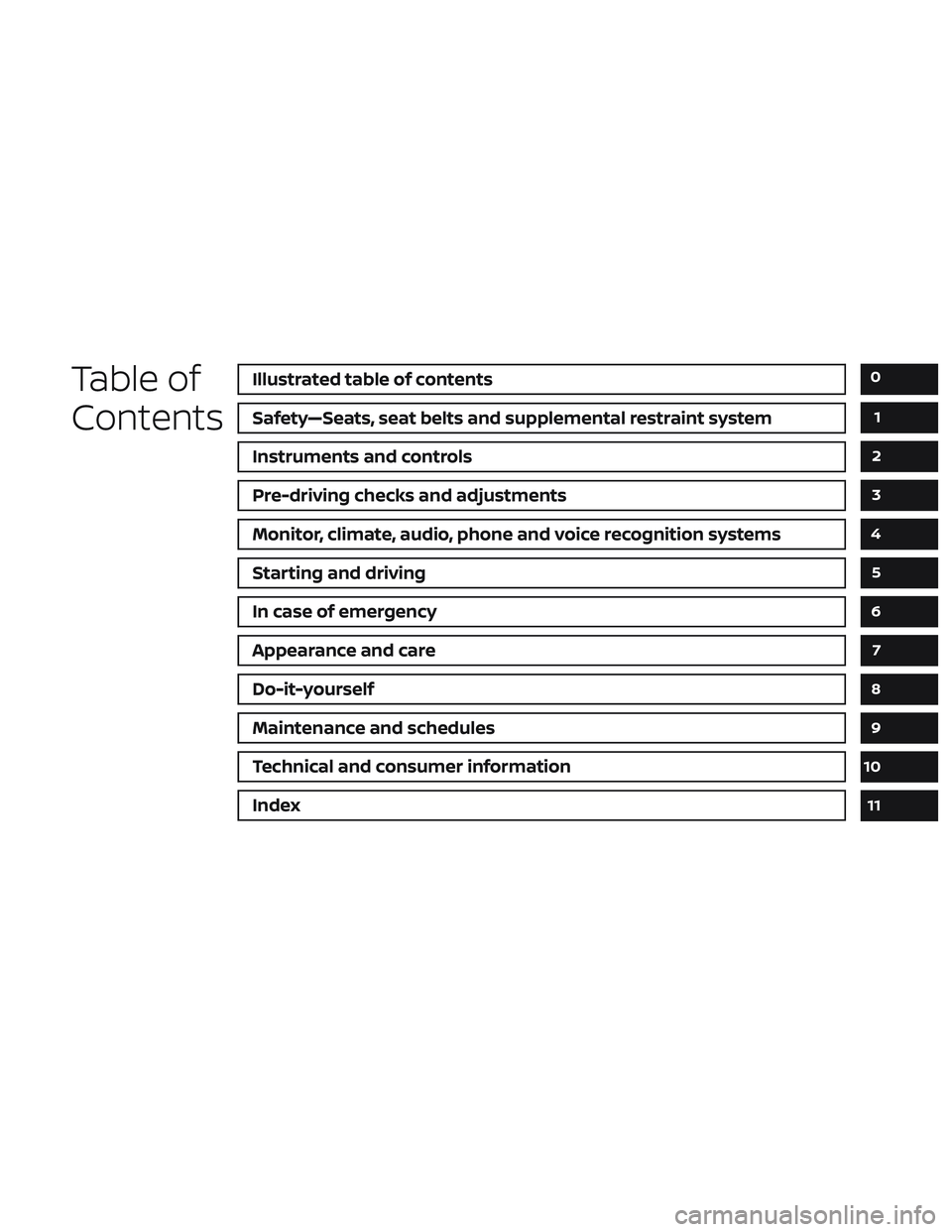
Table of
ContentsIllustrated table of contents
Safety—Seats, seat belts and supplemental restraint system
Instruments and controls
Pre-driving checks and adjustments
Monitor, climate, audio, phone and voice recognition systems
Starting and driving
In case of emergency
Appearance and care
Do-it-yourself
Maintenance and schedules
Technical and consumer information
Index
0
1
2
3
4
5
6
7
8
9
10
11
Page 21 of 426
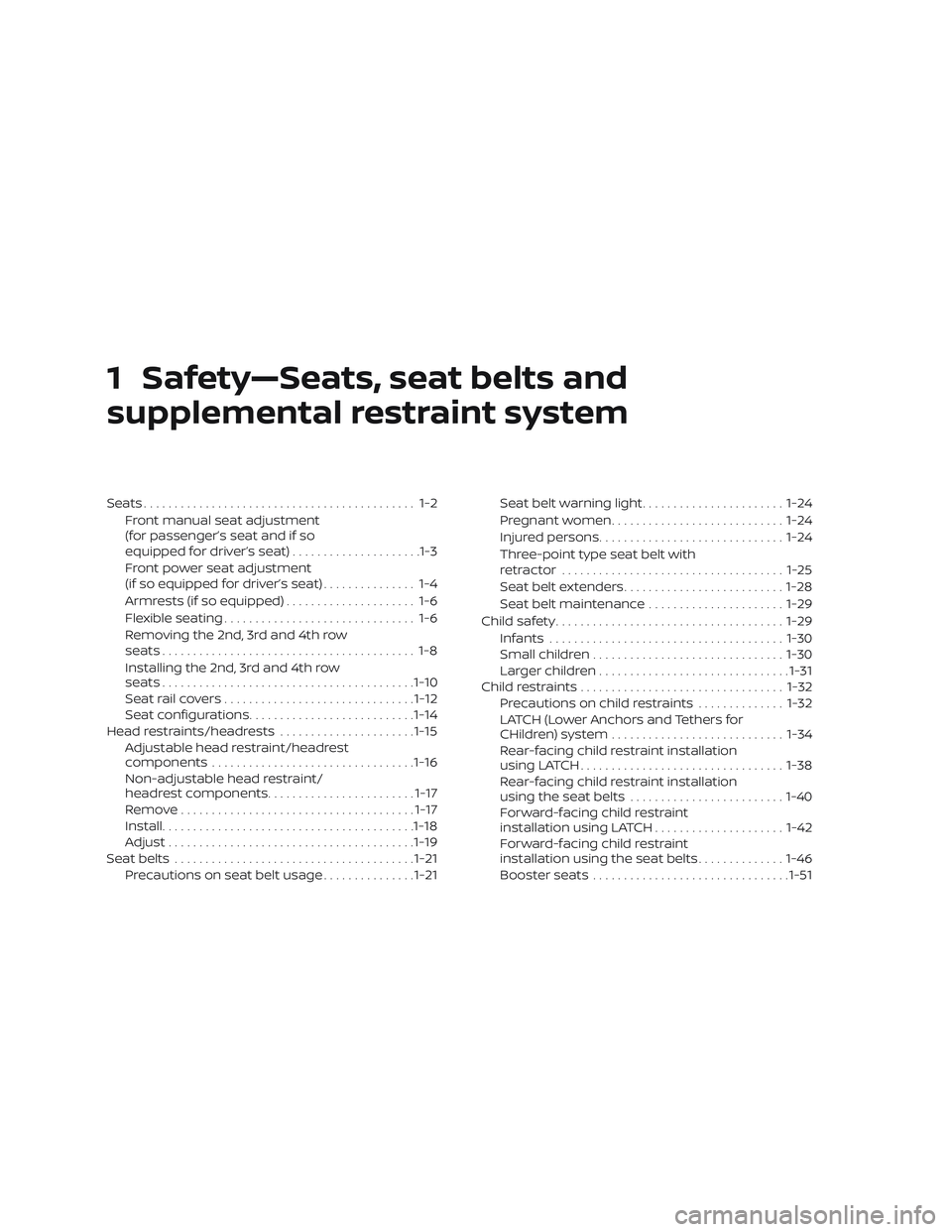
1 Safety—Seats, seat belts and
supplemental restraint system
Seats............................................ 1-2Front manual seat adjustment
(for passenger’s seat and if so
equipped for driver’s seat) .....................1-3
Front power seat adjustment
(if so equipped for driver’s seat) ............... 1-4
Armrests (if so equipped) ..................... 1-6
Flexible seating ............................... 1-6
Removing the 2nd, 3rd and 4th row
seats......................................... 1-8
Installing the 2nd, 3rd and 4th row
seats......................................... 1-10
Seatrailcovers............................... 1-12
Seat configurations ........................... 1-14
Head restraints/headrests ......................1-15
Adjustable head restraint/headrest
components ................................. 1-16
Non-adjustable head restraint/
headrest components ........................ 1-17
Remove...................................... 1-17
Install ......................................... 1-18
Adjust ........................................ 1-19
Seatbelts ....................................... 1-21
Precautions on seat belt usage ...............1-21Seat belt warning light
....................... 1-24
Pregnant women ............................ 1-24
Injured persons .............................. 1-24
Three-point type seat belt with
retractor .................................... 1-25
Seat belt extenders .......................... 1-28
Seat belt maintenance ......................1-29
Child safety ..................................... 1-29
Infants ...................................... 1-30
Small children ............................... 1-30
Larger children ............................... 1-31
Child restraints ................................. 1-32
Precautions on child restraints ..............1-32
LATCH (Lower Anchors and Tethers for
CHildren) system ............................ 1-34
Rear-facing child restraint installation
using LATCH ................................. 1-38
Rear-facing child restraint installation
using the seat belts ......................... 1-40
Forward-facing child restraint
installation using LATCH .....................1-42
Forward-facing child restraint
installation using the seat belts ..............1-46
Booster seats ................................ 1-51
Page 50 of 426
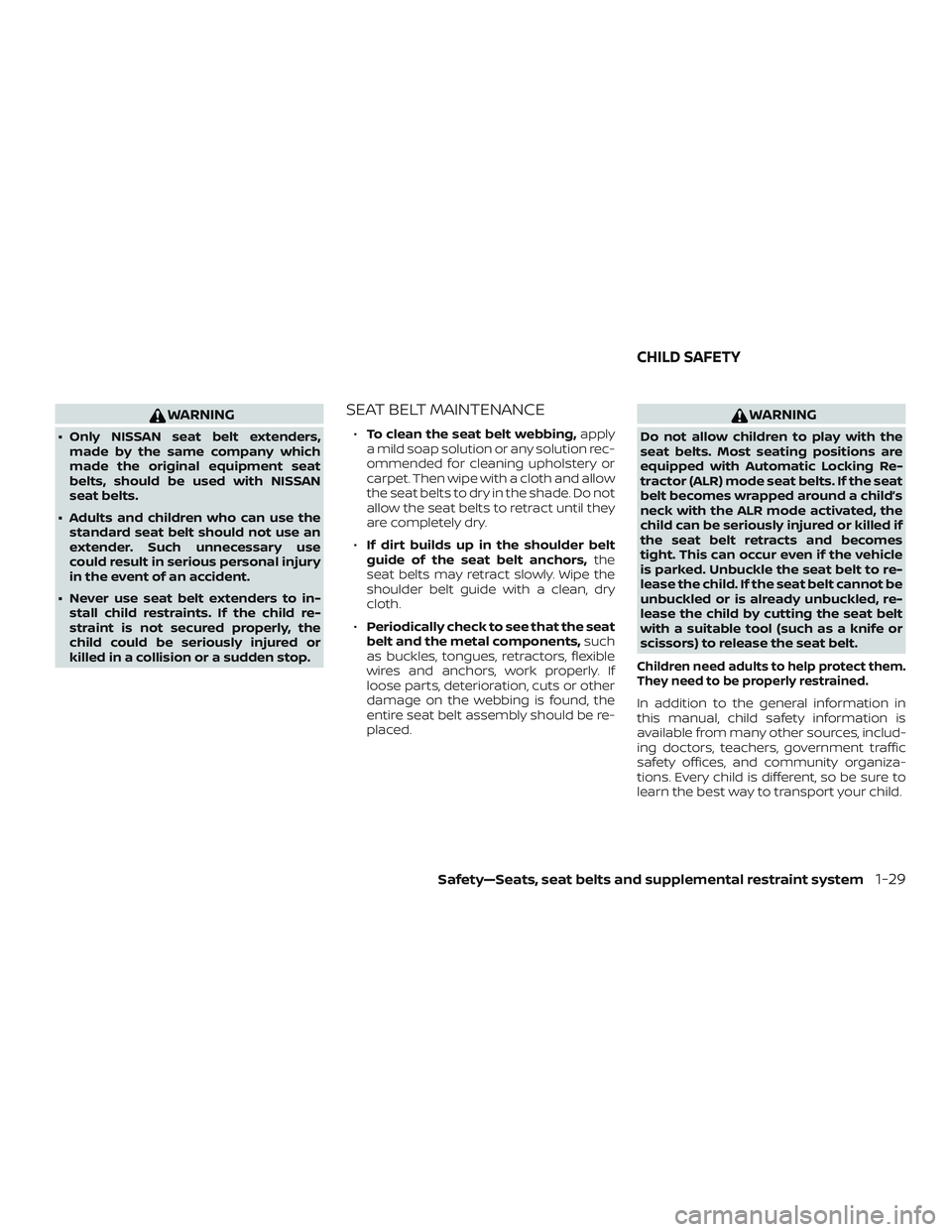
WARNING
∙ Only NISSAN seat belt extenders,made by the same company which
made the original equipment seat
belts, should be used with NISSAN
seat belts.
∙ Adults and children who can use the standard seat belt should not use an
extender. Such unnecessary use
could result in serious personal injury
in the event of an accident.
∙ Never use seat belt extenders to in- stall child restraints. If the child re-
straint is not secured properly, the
child could be seriously injured or
killed in a collision or a sudden stop.
SEAT BELT MAINTENANCE
∙ To clean the seat belt webbing, apply
a mild soap solution or any solution rec-
ommended for cleaning upholstery or
carpet. Then wipe with a cloth and allow
the seat belts to dry in the shade. Do not
allow the seat belts to retract until they
are completely dry.
∙ If dirt builds up in the shoulder belt
guide of the seat belt anchors, the
seat belts may retract slowly. Wipe the
shoulder belt guide with a clean, dry
cloth.
∙ Periodically check to see that the seat
belt and the metal components, such
as buckles, tongues, retractors, flexible
wires and anchors, work properly. If
loose parts, deterioration, cuts or other
damage on the webbing is found, the
entire seat belt assembly should be re-
placed.
WARNING
Do not allow children to play with the
seat belts. Most seating positions are
equipped with Automatic Locking Re-
tractor (ALR) mode seat belts. If the seat
belt becomes wrapped around a child’s
neck with the ALR mode activated, the
child can be seriously injured or killed if
the seat belt retracts and becomes
tight. This can occur even if the vehicle
is parked. Unbuckle the seat belt to re-
lease the child. If the seat belt cannot be
unbuckled or is already unbuckled, re-
lease the child by cutting the seat belt
with a suitable tool (such as a knife or
scissors) to release the seat belt.
Children need adults to help protect them.
They need to be properly restrained.
In addition to the general information in
this manual, child safety information is
available from many other sources, includ-
ing doctors, teachers, government traffic
safety offices, and community organiza-
tions. Every child is different, so be sure to
learn the best way to transport your child.
CHILD SAFETY
Safety—Seats, seat belts and supplemental restraint system1-29
Page 88 of 426
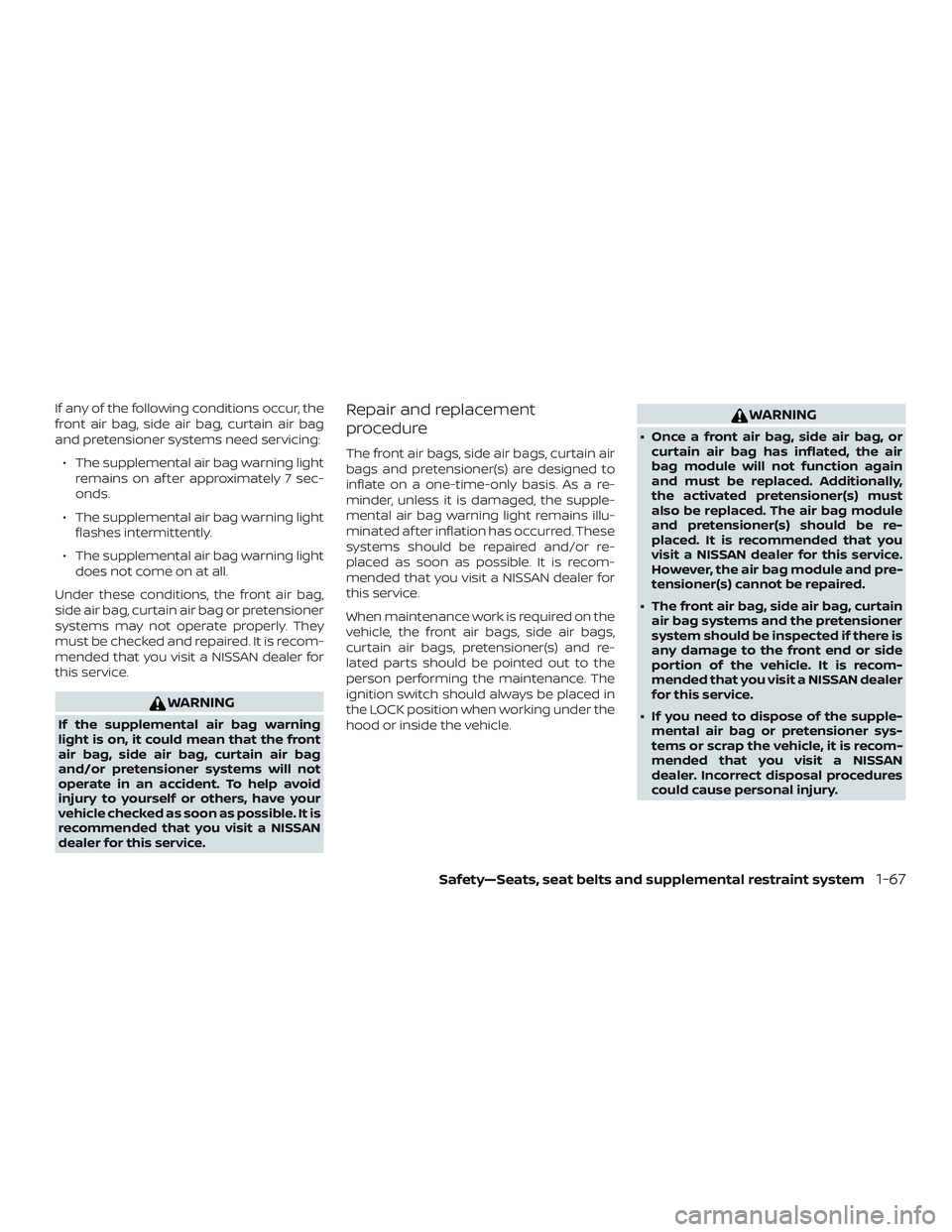
If any of the following conditions occur, the
front air bag, side air bag, curtain air bag
and pretensioner systems need servicing:∙ The supplemental air bag warning light remains on af ter approximately 7 sec-
onds.
∙ The supplemental air bag warning light flashes intermittently.
∙ The supplemental air bag warning light does not come on at all.
Under these conditions, the front air bag,
side air bag, curtain air bag or pretensioner
systems may not operate properly. They
must be checked and repaired. It is recom-
mended that you visit a NISSAN dealer for
this service.
WARNING
If the supplemental air bag warning
light is on, it could mean that the front
air bag, side air bag, curtain air bag
and/or pretensioner systems will not
operate in an accident. To help avoid
injury to yourself or others, have your
vehicle checked as soon as possible. It is
recommended that you visit a NISSAN
dealer for this service.
Repair and replacement
procedure
The front air bags, side air bags, curtain air
bags and pretensioner(s) are designed to
inflate on a one-time-only basis. As a re-
minder, unless it is damaged, the supple-
mental air bag warning light remains illu-
minated af ter inflation has occurred. These
systems should be repaired and/or re-
placed as soon as possible. It is recom-
mended that you visit a NISSAN dealer for
this service.
When maintenance work is required on the
vehicle, the front air bags, side air bags,
curtain air bags, pretensioner(s) and re-
lated parts should be pointed out to the
person performing the maintenance. The
ignition switch should always be placed in
the LOCK position when working under the
hood or inside the vehicle.
WARNING
∙ Once a front air bag, side air bag, or curtain air bag has inflated, the air
bag module will not function again
and must be replaced. Additionally,
the activated pretensioner(s) must
also be replaced. The air bag module
and pretensioner(s) should be re-
placed. It is recommended that you
visit a NISSAN dealer for this service.
However, the air bag module and pre-
tensioner(s) cannot be repaired.
∙ The front air bag, side air bag, curtain air bag systems and the pretensioner
system should be inspected if there is
any damage to the front end or side
portion of the vehicle. It is recom-
mended that you visit a NISSAN dealer
for this service.
∙ If you need to dispose of the supple- mental air bag or pretensioner sys-
tems or scrap the vehicle, it is recom-
mended that you visit a NISSAN
dealer. Incorrect disposal procedures
could cause personal injury.
Safety—Seats, seat belts and supplemental restraint system1-67
Page 98 of 426
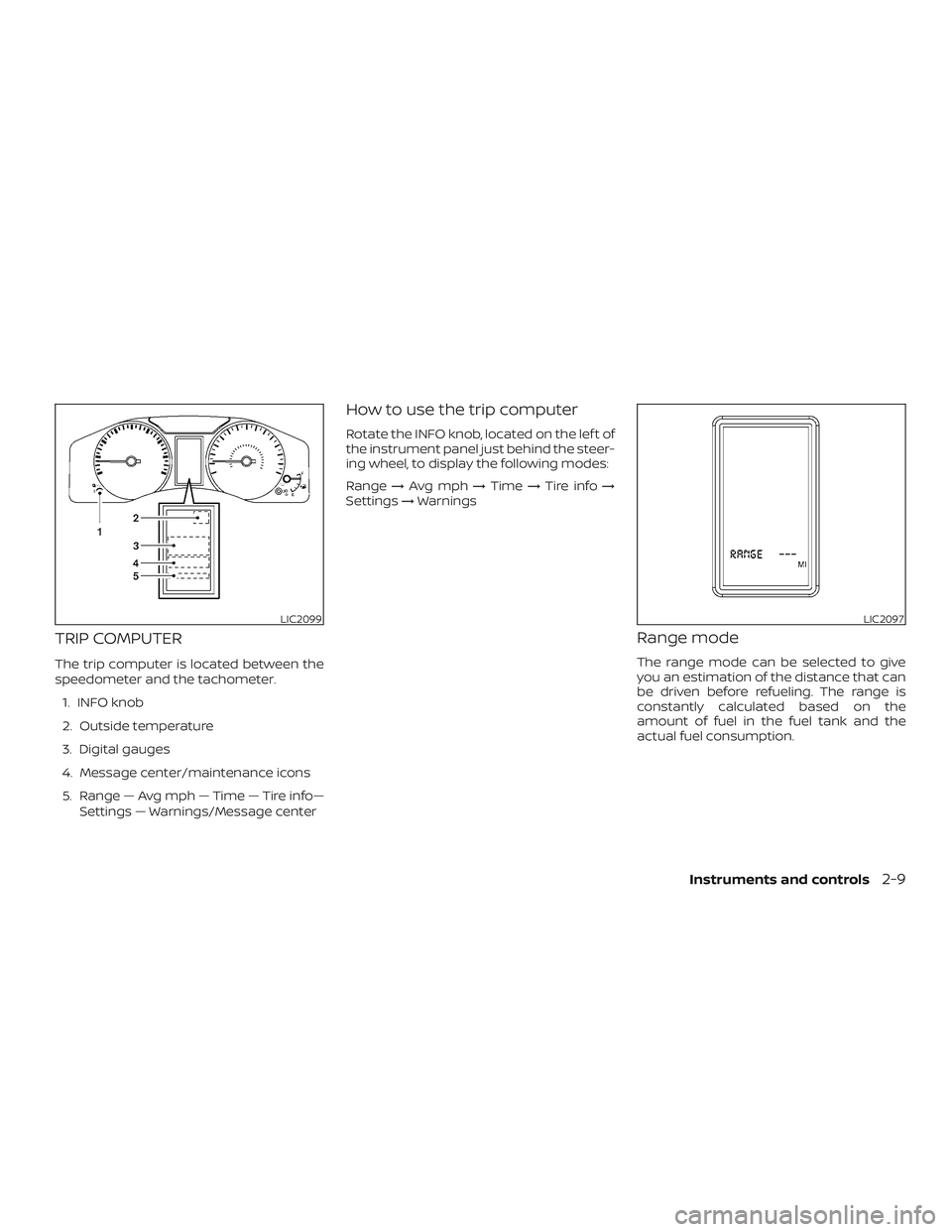
TRIP COMPUTER
The trip computer is located between the
speedometer and the tachometer.1. INFO knob
2. Outside temperature
3. Digital gauges
4. Message center/maintenance icons
5. Range — Avg mph — Time — Tire info— Settings — Warnings/Message center
How to use the trip computer
Rotate the INFO knob, located on the lef t of
the instrument panel just behind the steer-
ing wheel, to display the following modes:
Range →Avg mph →Time →Tire info →
Settings →Warnings
Range mode
The range mode can be selected to give
you an estimation of the distance that can
be driven before refueling. The range is
constantly calculated based on the
amount of fuel in the fuel tank and the
actual fuel consumption.
LIC2099LIC2097
Instruments and controls2-9
Page 100 of 426
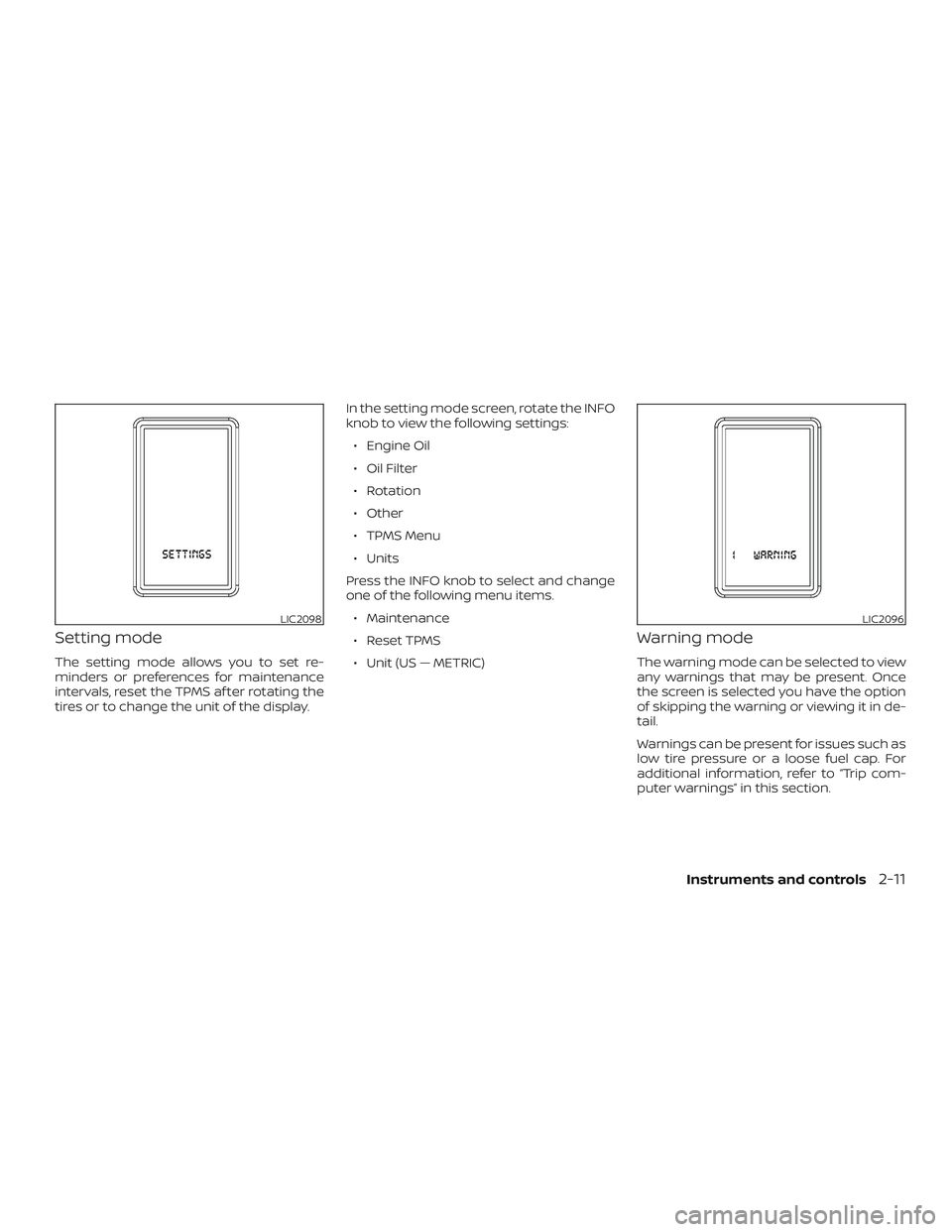
Setting mode
The setting mode allows you to set re-
minders or preferences for maintenance
intervals, reset the TPMS af ter rotating the
tires or to change the unit of the display.In the setting mode screen, rotate the INFO
knob to view the following settings:
∙ Engine Oil
∙ Oil Filter
∙ Rotation
∙ Other
∙ TPMS Menu
∙ Units
Press the INFO knob to select and change
one of the following menu items. ∙ Maintenance
∙ Reset TPMS
∙ Unit (US — METRIC)
Warning mode
The warning mode can be selected to view
any warnings that may be present. Once
the screen is selected you have the option
of skipping the warning or viewing it in de-
tail.
Warnings can be present for issues such as
low tire pressure or a loose fuel cap. For
additional information, refer to “Trip com-
puter warnings” in this section.
LIC2098LIC2096
Instruments and controls2-11
Page 101 of 426
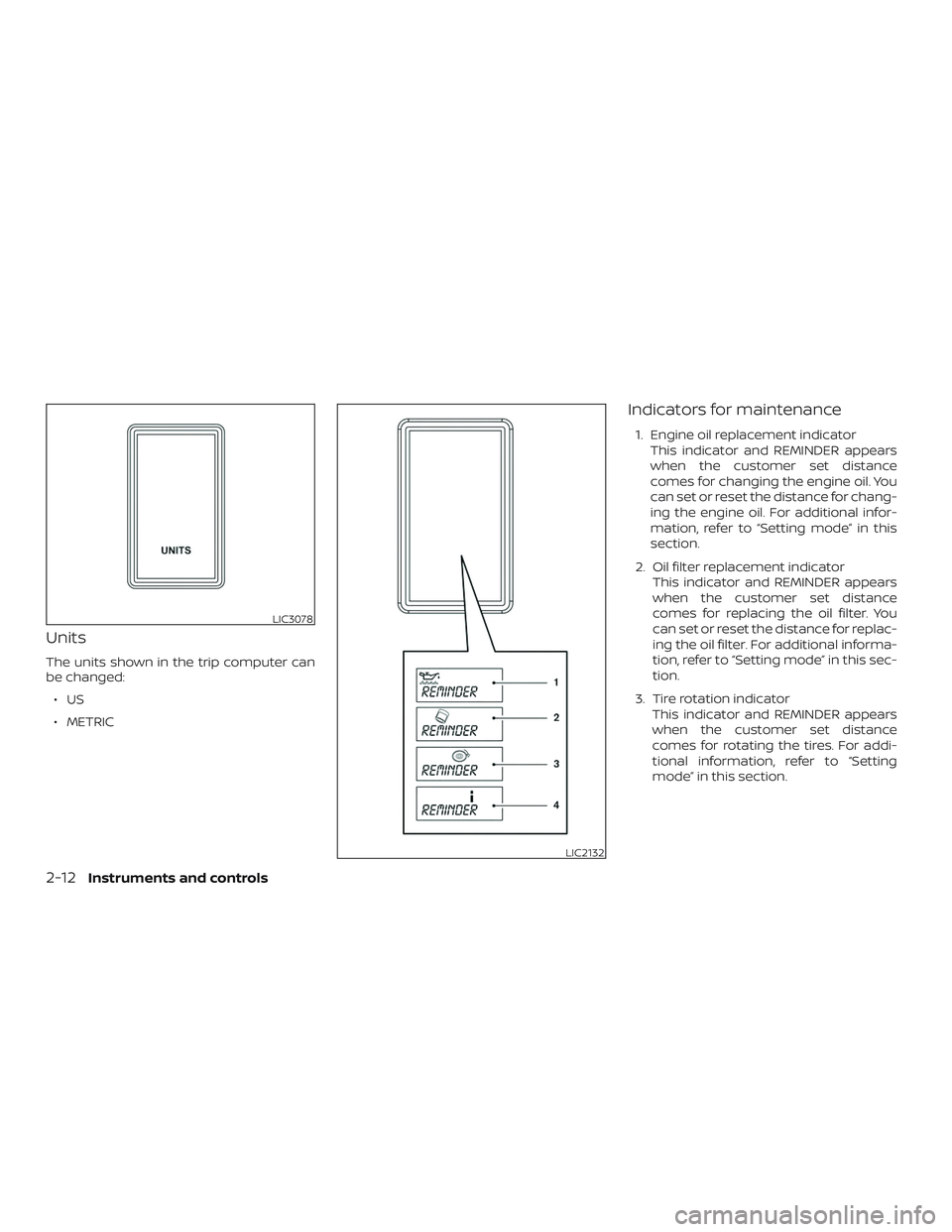
Units
The units shown in the trip computer can
be changed:∙US
∙ METRIC
Indicators for maintenance
1. Engine oil replacement indicator This indicator and REMINDER appears
when the customer set distance
comes for changing the engine oil. You
can set or reset the distance for chang-
ing the engine oil. For additional infor-
mation, refer to “Setting mode” in this
section.
2. Oil filter replacement indicator This indicator and REMINDER appears
when the customer set distance
comes for replacing the oil filter. You
can set or reset the distance for replac-
ing the oil filter. For additional informa-
tion, refer to “Setting mode” in this sec-
tion.
3. Tire rotation indicator This indicator and REMINDER appears
when the customer set distance
comes for rotating the tires. For addi-
tional information, refer to “Setting
mode” in this section.
LIC3078
LIC2132
2-12Instruments and controls
Page 102 of 426
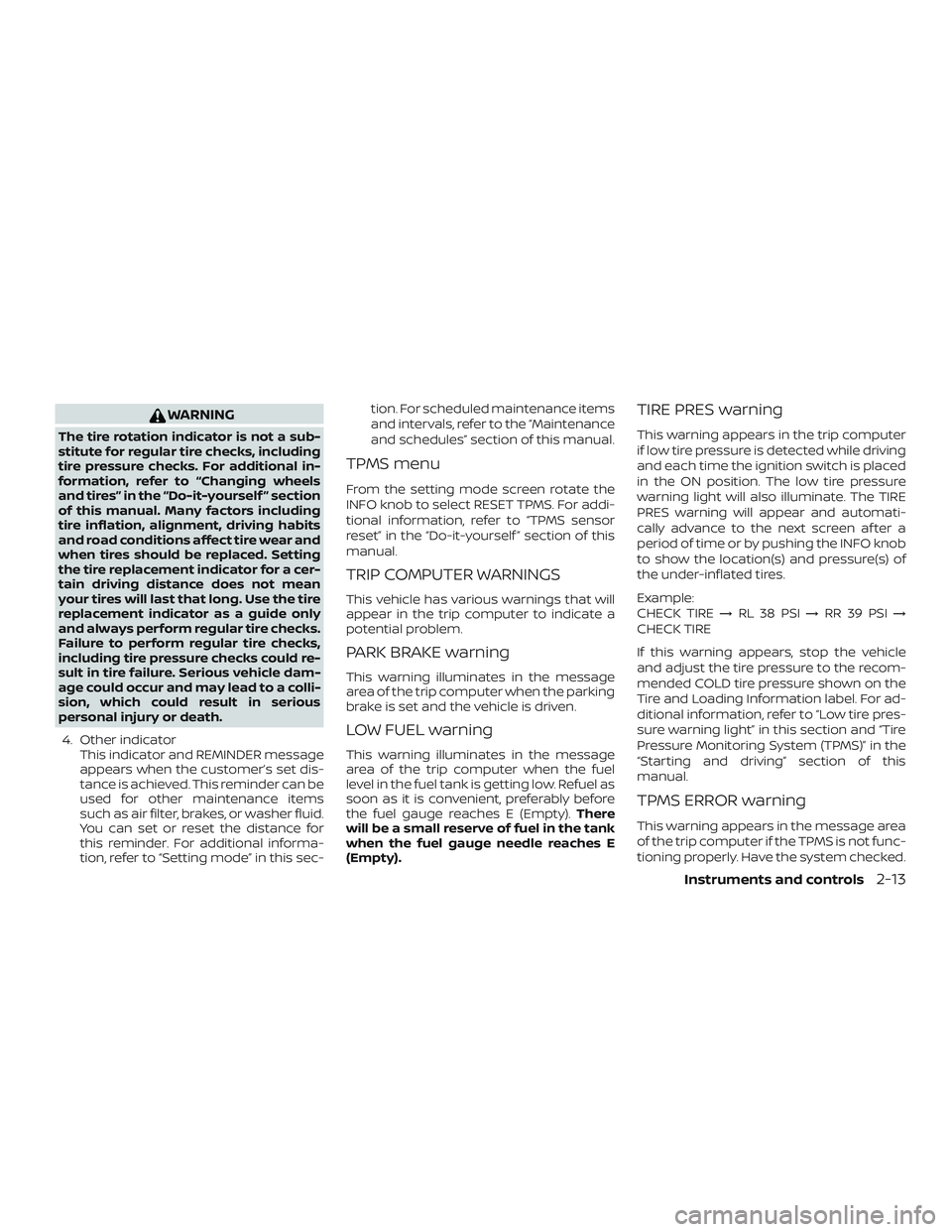
WARNING
The tire rotation indicator is not a sub-
stitute for regular tire checks, including
tire pressure checks. For additional in-
formation, refer to “Changing wheels
and tires” in the “Do-it-yourself ” section
of this manual. Many factors including
tire inflation, alignment, driving habits
and road conditions affect tire wear and
when tires should be replaced. Setting
the tire replacement indicator for a cer-
tain driving distance does not mean
your tires will last that long. Use the tire
replacement indicator as a guide only
and always perform regular tire checks.
Failure to perform regular tire checks,
including tire pressure checks could re-
sult in tire failure. Serious vehicle dam-
age could occur and may lead to a colli-
sion, which could result in serious
personal injury or death.4. Other indicator This indicator and REMINDER message
appears when the customer’s set dis-
tance is achieved. This reminder can be
used for other maintenance items
such as air filter, brakes, or washer fluid.
You can set or reset the distance for
this reminder. For additional informa-
tion, refer to “Setting mode” in this sec- tion. For scheduled maintenance items
and intervals, refer to the “Maintenance
and schedules” section of this manual.
TPMS menu
From the setting mode screen rotate the
INFO knob to select RESET TPMS. For addi-
tional information, refer to “TPMS sensor
reset” in the “Do-it-yourself ” section of this
manual.
TRIP COMPUTER WARNINGS
This vehicle has various warnings that will
appear in the trip computer to indicate a
potential problem.
PARK BRAKE warning
This warning illuminates in the message
area of the trip computer when the parking
brake is set and the vehicle is driven.
LOW FUEL warning
This warning illuminates in the message
area of the trip computer when the fuel
level in the fuel tank is getting low. Refuel as
soon as it is convenient, preferably before
the fuel gauge reaches E (Empty).
There
will be a small reserve of fuel in the tank
when the fuel gauge needle reaches E
(Empty).
TIRE PRES warning
This warning appears in the trip computer
if low tire pressure is detected while driving
and each time the ignition switch is placed
in the ON position. The low tire pressure
warning light will also illuminate. The TIRE
PRES warning will appear and automati-
cally advance to the next screen af ter a
period of time or by pushing the INFO knob
to show the location(s) and pressure(s) of
the under-inflated tires.
Example:
CHECK TIRE →RL 38 PSI →RR 39 PSI →
CHECK TIRE
If this warning appears, stop the vehicle
and adjust the tire pressure to the recom-
mended COLD tire pressure shown on the
Tire and Loading Information label. For ad-
ditional information, refer to “Low tire pres-
sure warning light” in this section and “Tire
Pressure Monitoring System (TPMS)” in the
“Starting and driving” section of this
manual.
TPMS ERROR warning
This warning appears in the message area
of the trip computer if the TPMS is not func-
tioning properly. Have the system checked.
Instruments and controls2-13